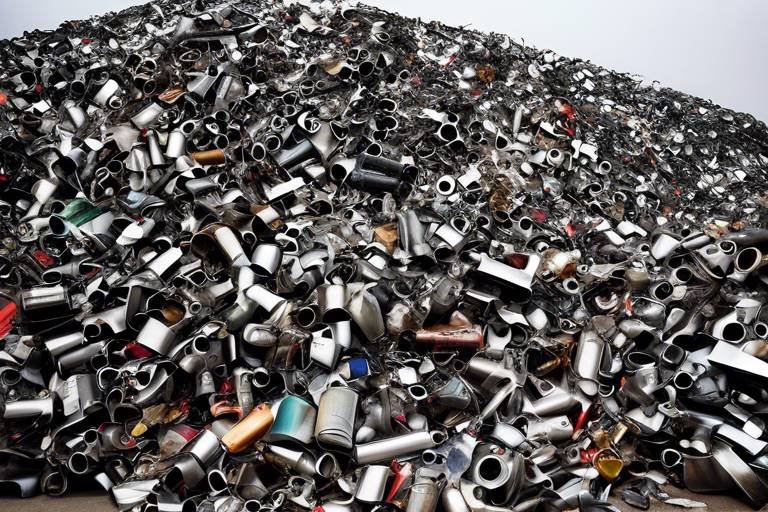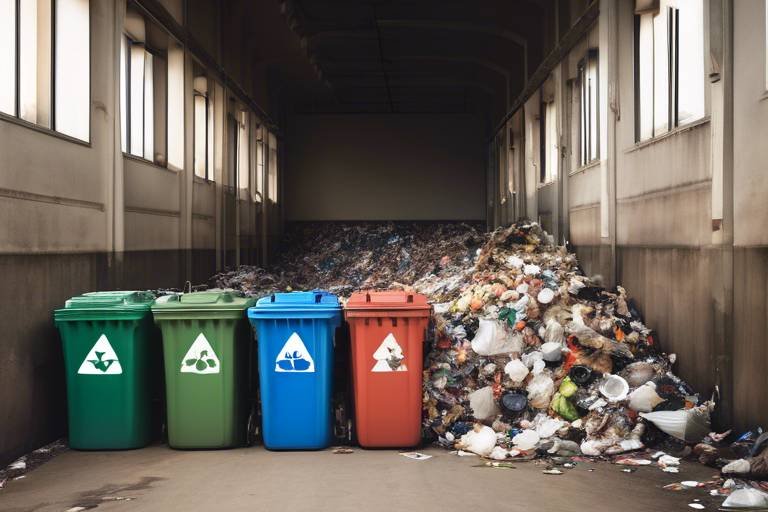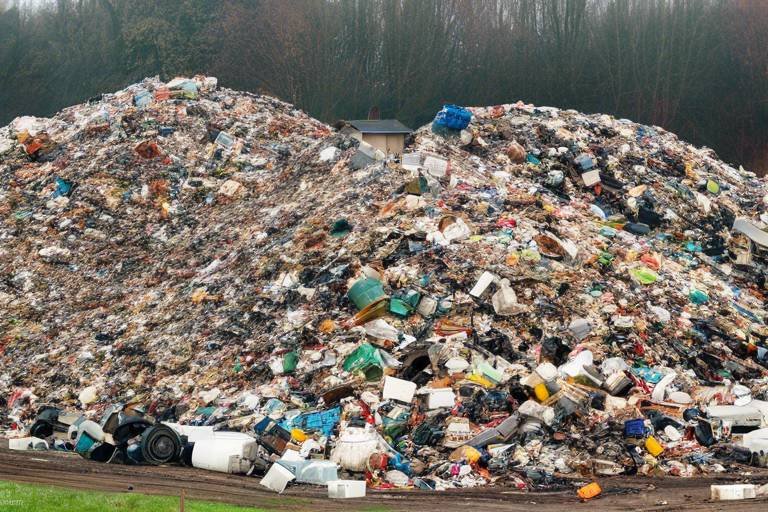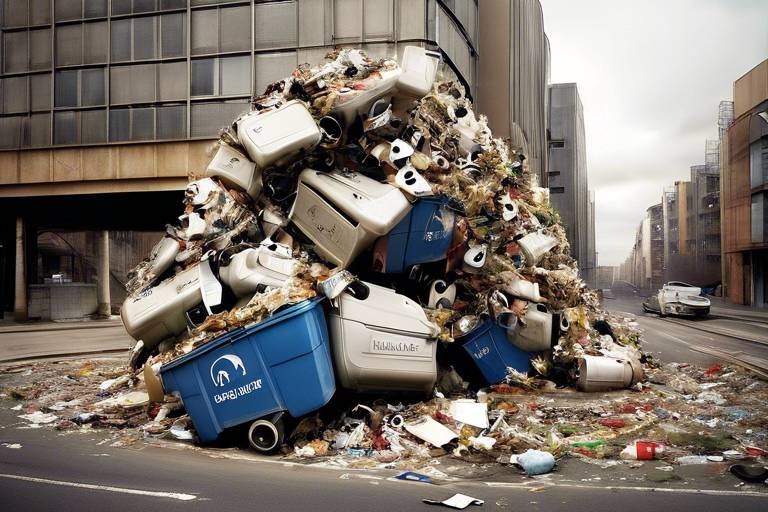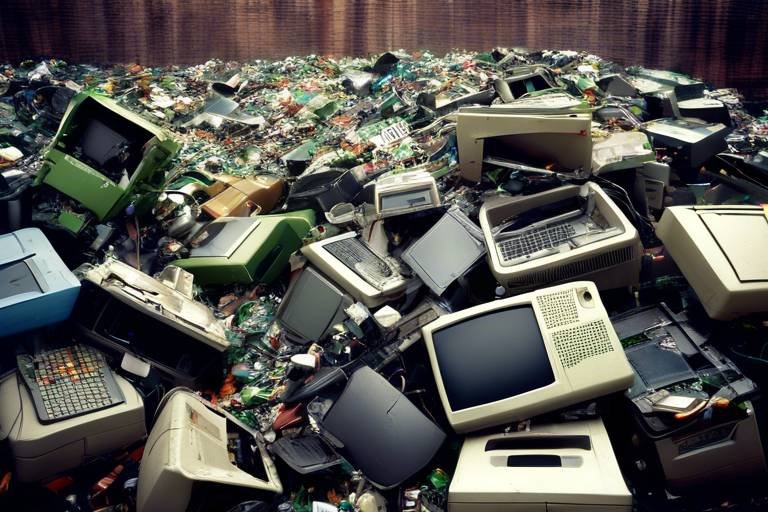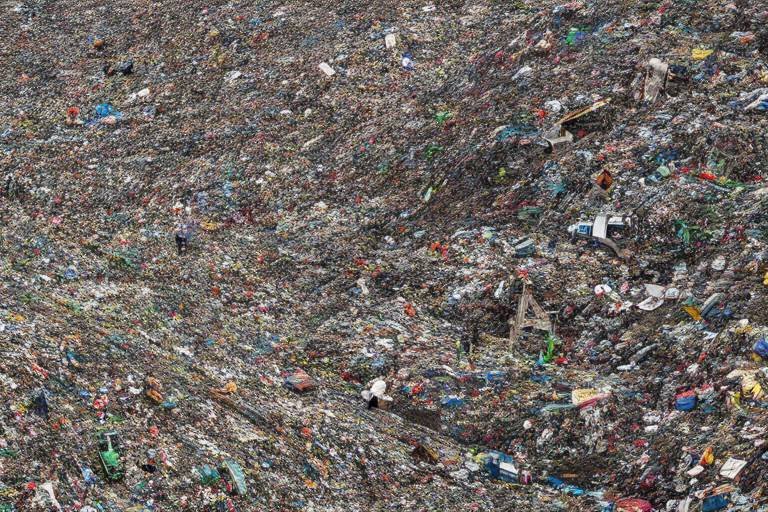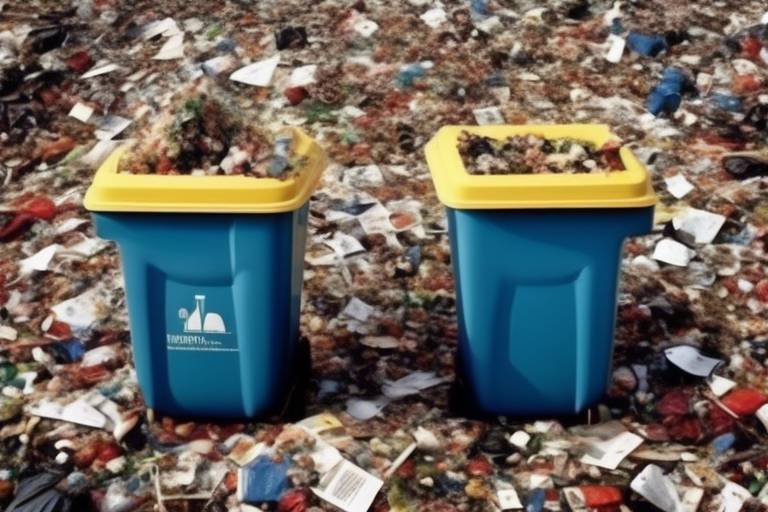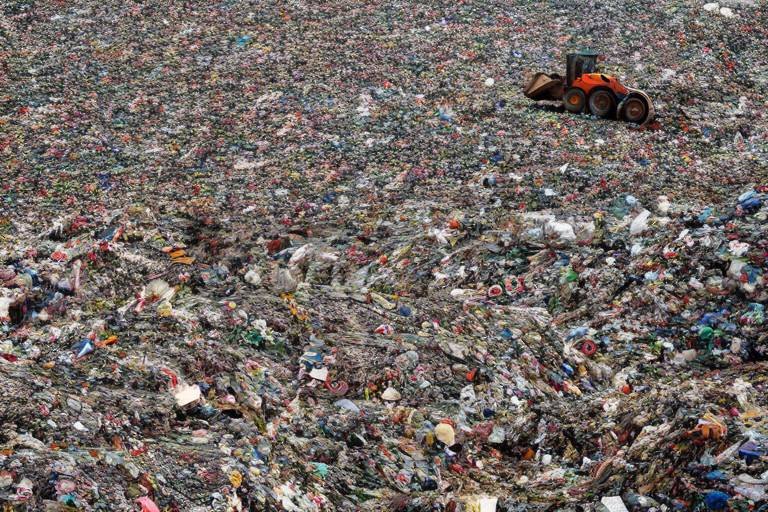The Environmental Impact of Metal Recycling
In today's world, where environmental concerns are at the forefront of global discussions, the significance of metal recycling cannot be overstated. It is not just a process; it's a lifeline for our planet, a way to combat waste and conserve precious resources. Imagine a world where discarded metals are transformed into new products, reducing the need for mining and minimizing pollution. This is the reality that metal recycling aims to create, and understanding its impact is crucial for anyone who cares about sustainability.
So, why is metal recycling so important? Well, it plays a vital role in sustainability by conserving natural resources and significantly reducing landfill waste. Every can, car, or piece of scrap metal that gets recycled is one less item contributing to the ever-growing mountains of trash. Think of it this way: when we recycle metals, we are not just saving materials; we are also preserving the environment for future generations. It’s like giving our planet a much-needed break from the relentless extraction of raw materials.
Metal recycling is a superhero in the fight against environmental degradation. It offers a plethora of benefits, including a significant reduction in greenhouse gas emissions, energy conservation, and a decrease in the need for mining. Each of these factors plays a crucial role in creating a healthier planet for all of us. For instance, the energy saved from recycling metals can power homes and businesses, showcasing how one small act can lead to monumental changes.
Did you know that recycling metals uses considerably less energy compared to producing new metals from ore? This is a game changer! By recycling, we can cut down on fossil fuel consumption and reduce our carbon footprints. For example, recycling aluminum saves about 90% of the energy required to create new aluminum from bauxite ore. That’s like turning off your lights for a week just by recycling that soda can!
When we analyze the energy savings from recycling versus mining, the differences are staggering. The table below illustrates the energy consumption for producing metals:
| Metal Type | Energy Use (MJ/kg) from Mining | Energy Use (MJ/kg) from Recycling |
|---|---|---|
| Aluminum | 160 | 15 |
| Copper | 80 | 25 |
| Steel | 20 | 7 |
This table clearly shows that recycling is not just a smart choice; it's an essential practice for conserving energy and protecting our environment.
Moreover, the integration of renewable energy sources in recycling processes is a promising trend. By utilizing solar or wind energy in metal recycling, we can further enhance energy conservation. This not only promotes a sustainable future but also sets a precedent for other industries to follow suit. Imagine a world where recycling facilities are powered entirely by clean energy—now that’s a vision worth striving for!
Another major benefit of metal recycling is the reduction of pollution. Mining and processing metals often release harmful substances into the air and water, contributing to pollution and health hazards. By recycling metals, we can significantly decrease the need for these destructive practices. It’s like giving our air and water a detox! The less we mine, the less we pollute, and the healthier our planet becomes.
Despite its numerous benefits, metal recycling is not without challenges. Issues such as contamination, fluctuating market prices, and the need for advanced technology can hinder the efficiency of recycling operations. Understanding these challenges is essential for improving the overall effectiveness of metal recycling.
One of the biggest hurdles in metal recycling is contamination. When materials are mixed with non-recyclable items, it can lead to inefficient operations and lower quality recycled metals. Imagine trying to bake a cake with spoiled ingredients—it's not going to turn out well! Similarly, contaminated materials can ruin the recycling process, resulting in wasted resources and increased costs.
The recycling industry is also subject to volatile market prices, which can impact the economic viability of recycling operations. When prices drop, recycling facilities may struggle to stay afloat, leading to less recycling and more waste. It’s a tricky balance, but one that must be navigated to ensure the future of metal recycling remains bright.
Looking ahead, the future of metal recycling is promising, thanks to innovations in technology and policy. These advancements can enhance recycling efficiency and expand its role in a circular economy, where materials are reused and recycled continuously.
Emerging technologies, such as automation and artificial intelligence, are revolutionizing metal recycling processes. These innovations make recycling more efficient and cost-effective, ensuring that we can recycle more materials with less effort. It’s like upgrading from a flip phone to a smartphone—everything becomes easier and more efficient!
Finally, government policies and regulations play a crucial role in promoting metal recycling. By incentivizing sustainable practices and ensuring environmental protection, we can create a supportive framework for the recycling industry to thrive. This is essential for fostering a culture of recycling and sustainability.
- What metals can be recycled? Most metals, including aluminum, copper, steel, and brass, can be recycled.
- How does recycling help the environment? Recycling reduces waste, conserves natural resources, saves energy, and decreases pollution.
- Is metal recycling profitable? Yes, but it can be affected by market fluctuations and contamination issues.
- What can I do to support metal recycling? You can recycle your metal products, educate others about the importance of recycling, and support policies that promote recycling efforts.

The Importance of Metal Recycling
Understanding why metal recycling is crucial for sustainability can help us appreciate its role in conserving natural resources and reducing landfill waste. Every year, millions of tons of metal end up in landfills, contributing to the growing problem of waste management. But what if I told you that recycling just one ton of aluminum can save up to 8 tons of bauxite ore? That's a staggering figure that illustrates the profound impact recycling can have on resource conservation.
Metal recycling is not just a trend; it's a necessity for a sustainable future. By recycling metals, we significantly reduce the need for new raw materials, which in turn decreases the environmental degradation associated with mining. Mining operations are notorious for their destructive impact on ecosystems, often leading to habitat loss, soil erosion, and water pollution. By recycling, we can mitigate these adverse effects and promote a healthier planet.
Moreover, the recycling process itself is far less energy-intensive than extracting and processing new metals. For instance, producing recycled aluminum uses about 95% less energy compared to creating aluminum from raw materials. This energy conservation translates to fewer fossil fuels burned, resulting in a substantial reduction in greenhouse gas emissions. It's a win-win situation: we save energy, reduce pollution, and conserve precious natural resources.
In addition to these benefits, metal recycling fosters a circular economy where materials are reused and repurposed rather than discarded. This approach not only conserves resources but also creates jobs in the recycling industry, contributing to economic growth. As we embrace recycling, we become part of a larger movement towards sustainability, where every action counts.
In summary, the importance of metal recycling cannot be overstated. It is a critical component of environmental sustainability that helps us preserve our planet for future generations. By recycling metals, we conserve resources, reduce energy consumption, and minimize pollution—all essential steps in the fight against climate change. So next time you think about tossing that aluminum can in the trash, remember the impact your choice can have. Together, we can make a difference, one piece of metal at a time.

Environmental Benefits of Metal Recycling
When we think about the environment, the first thing that often comes to mind is the vastness of our planet and the beauty it holds. However, with industrialization and urbanization, our planet faces significant challenges, particularly in terms of waste management and resource depletion. This is where metal recycling comes into play, acting as a beacon of hope for a more sustainable future. By recycling metals, we not only reduce the amount of waste sent to landfills but also conserve precious natural resources and minimize pollution. Isn't it fascinating how a simple act of recycling can have such a profound impact?
One of the most significant environmental benefits of metal recycling is its ability to reduce greenhouse gas emissions. The process of extracting and processing raw materials from the earth is energy-intensive and often involves the burning of fossil fuels. In contrast, recycling metals requires considerably less energy, which directly translates to lower emissions. For instance, recycling aluminum saves up to 95% of the energy required to produce new aluminum from bauxite ore. Imagine the difference we could make if more people embraced recycling!
Moreover, metal recycling helps to conserve energy on a massive scale. When we recycle metals, we are essentially giving them a second life, which means we’re not only saving energy but also reducing the need for new material extraction. This process significantly decreases our reliance on non-renewable energy sources. To illustrate, consider the following table that compares the energy consumption of recycling versus mining:
| Metal Type | Energy Used in Mining (MJ/kg) | Energy Used in Recycling (MJ/kg) |
|---|---|---|
| Aluminum | 170 | 7 |
| Copper | 80 | 20 |
| Steel | 20 | 5 |
This table clearly shows that recycling metals is not just a good idea; it's a smart choice for energy conservation. By integrating renewable energy sources into recycling processes, we can further enhance these benefits. Imagine a world where solar and wind energy power the recycling centers, making the entire process even more sustainable and efficient!
Another critical aspect of metal recycling is its role in pollution reduction. Traditional mining and metal production release harmful pollutants into the air and water, contributing to environmental degradation and health issues. By recycling metals, we significantly decrease the need for mining, which in turn reduces the pollution associated with these activities. This is particularly important in regions where mining operations have devastated local ecosystems. The less we mine, the more we protect our planet's delicate balance.
In conclusion, the environmental benefits of metal recycling are multifaceted and impactful. From reducing greenhouse gas emissions and conserving energy to minimizing pollution, recycling metals is a vital component of a sustainable future. It’s not just about saving resources; it’s about creating a cleaner, healthier planet for generations to come. So, the next time you see a recycling bin, remember that you’re not just tossing away a can or a piece of scrap metal; you’re making a choice that can lead to a brighter, greener future.
- What types of metals can be recycled? Most metals, including aluminum, copper, steel, and brass, can be recycled. Check local guidelines for specific recycling options.
- How does metal recycling benefit the economy? Metal recycling creates jobs, reduces the cost of raw materials, and decreases the need for landfill space, contributing to a more sustainable economy.
- Can recycling metal really make a difference? Absolutely! Every piece of metal recycled saves energy, reduces pollution, and conserves natural resources, making a significant impact over time.

Energy Conservation
This article explores the various environmental benefits and challenges associated with metal recycling, highlighting its significance in reducing waste, conserving resources, and mitigating pollution.
Understanding why metal recycling is crucial for sustainability can help us appreciate its role in conserving natural resources and reducing landfill waste.
Metal recycling significantly reduces greenhouse gas emissions, conserves energy, and minimizes the need for mining, leading to a healthier planet.
When we talk about in the context of metal recycling, the numbers are truly eye-opening. Recycling metals uses considerably less energy compared to producing new metals from raw ore. In fact, it’s estimated that recycling aluminum saves about 90% of the energy required to create it from bauxite ore. This is not just a small win; it’s a massive leap towards a more sustainable future.
But how does this translate into real-world benefits? For one, less energy consumption means a lower demand for fossil fuels, which are notorious for their role in greenhouse gas emissions. By choosing to recycle, we’re not just saving energy; we’re also taking a stand against climate change. Imagine every aluminum can you recycle as a tiny soldier in the battle for a cleaner planet. Each one contributes to a larger army fighting against pollution and resource depletion.
To truly grasp the impact of recycling, let’s dive into a comparative analysis. Consider the following table that illustrates the energy savings from recycling various metals versus mining them:
| Metal Type | Energy Saved by Recycling (%) |
|---|---|
| Aluminum | 90% |
| Copper | 85% |
| Steel | 60% |
| Lead | 70% |
This table vividly shows that recycling not only cuts energy use but also significantly reduces the environmental impact associated with mining. Each percentage point saved is a step closer to preserving our planet’s resources.
Moreover, the integration of renewable energy sources in recycling processes is a game changer. Imagine a recycling facility powered by solar panels or wind turbines. This not only enhances energy conservation but also promotes a sustainable future. By harnessing the power of nature, we can further minimize our carbon footprint and create a closed-loop system where energy is not just consumed but also regenerated.
In conclusion, energy conservation through metal recycling is not merely an environmental strategy; it's a necessary approach to ensure our planet remains habitable for generations to come. By recycling metals, we can save energy, reduce emissions, and pave the way for a cleaner, greener future.
Despite its benefits, metal recycling faces challenges such as contamination, fluctuating market prices, and the need for advanced technology to improve efficiency.
Contaminated materials can hinder the recycling process, leading to inefficient operations and lower quality recycled metals.
The recycling industry is subject to volatile market prices, impacting the economic viability of recycling operations and influencing investment decisions.
Innovations in technology and policy can shape the future of metal recycling, enhancing its efficiency and expanding its role in a circular economy.
Emerging technologies, such as automation and AI, are revolutionizing metal recycling processes, making them more efficient and cost-effective.
Government policies and regulations play a crucial role in promoting metal recycling, incentivizing sustainable practices, and ensuring environmental protection.
- What types of metals can be recycled? Most metals, including aluminum, copper, steel, and brass, can be recycled.
- How does metal recycling help the environment? It conserves energy, reduces greenhouse gas emissions, and decreases the need for mining.
- Is recycling metal more cost-effective than mining? Generally, yes, as it requires less energy and resources, making it a more sustainable option.

Comparative Energy Use
When we talk about energy conservation in metal recycling, it’s essential to understand just how much energy we save compared to traditional mining processes. Imagine this: recycling aluminum, for example, uses about 95% less energy than producing it from raw bauxite ore. This staggering difference isn't just a number; it translates into a significant reduction in fossil fuel consumption and a smaller carbon footprint. To put this into perspective, let’s look at some comparative figures:
| Metal Type | Energy Use (MJ/kg) | Energy Savings (%) |
|---|---|---|
| Aluminum | 5.5 | 95 |
| Copper | 1.5 | 85 |
| Steel | 1.0 | 74 |
This table illustrates the remarkable energy savings associated with recycling various metals. For instance, recycling copper saves about 85% of the energy required to mine and process new copper. This is not just beneficial for the environment; it also makes economic sense. Lower energy consumption means lower operational costs, which can lead to a more sustainable recycling industry.
Moreover, the integration of renewable energy sources into recycling operations can amplify these benefits even further. Imagine a recycling facility powered by solar or wind energy. Not only does this reduce reliance on fossil fuels, but it also enhances the overall sustainability of the recycling process. The potential for a greener future is immense, and as technology advances, we can expect to see even more efficient methods of recycling that capitalize on these energy savings.
In conclusion, the comparative energy use in metal recycling highlights the efficiency of this process. By choosing to recycle metals, we are not only conserving energy but also paving the way for a cleaner, more sustainable planet. Every bit of metal recycled contributes to a significant reduction in energy consumption, making metal recycling a critical player in our fight against climate change.
- What metals can be recycled? Almost all metals can be recycled, including aluminum, copper, steel, and iron.
- How does recycling help the environment? Recycling reduces waste, conserves natural resources, and lowers greenhouse gas emissions.
- Can I recycle metal at home? Yes, many local municipalities have programs for recycling metals, and you can also take them to scrap yards.
- What happens to recycled metals? Recycled metals are melted down and reprocessed to create new products.

Renewable Energy Integration
As we embrace the pressing need for sustainable practices, the integration of renewable energy sources into metal recycling processes emerges as a game changer. Imagine a world where the energy required to recycle metals doesn't come from fossil fuels but from the sun, wind, or even geothermal sources. This shift not only reduces dependency on non-renewable energy but also significantly lowers the carbon footprint associated with metal recycling.
When we talk about renewable energy integration, we’re not just discussing a theoretical concept; we’re witnessing a practical transformation in how recycling facilities operate. For instance, solar panels installed on the roofs of recycling plants can harness sunlight to power machinery, while wind turbines can generate electricity to run operations. This dual approach not only enhances energy efficiency but also contributes to a more sustainable future.
Furthermore, the use of renewable energy in metal recycling can lead to substantial cost savings in the long run. By relying on renewable sources, facilities can mitigate the impact of fluctuating energy prices, thus stabilizing their operational costs. A recent study showed that recycling plants utilizing renewable energy sources experienced a 25% reduction in energy costs compared to those relying solely on traditional power sources. This financial incentive is a compelling reason for more recycling operations to transition to greener energy.
However, the integration of renewable energy is not without its challenges. Initial setup costs for solar panels or wind turbines can be significant, and the technology must be tailored to the specific needs of the recycling process. Moreover, the availability of renewable resources can fluctuate, necessitating a robust energy management system to ensure a consistent power supply. Despite these hurdles, the long-term benefits far outweigh the challenges, paving the way for a more resilient and eco-friendly recycling industry.
In conclusion, the integration of renewable energy into metal recycling processes is not merely an option; it is becoming a necessity. As we strive for a more sustainable world, the collaboration between recycling operations and renewable energy providers will be vital. By harnessing the power of nature, we can significantly enhance the efficiency of metal recycling, reduce environmental impact, and promote a circular economy where resources are reused and recycled, rather than discarded.
- What is metal recycling? Metal recycling is the process of recovering scrap metal from products that are no longer in use, which can then be reprocessed into new metal products.
- How does metal recycling benefit the environment? It reduces waste, conserves natural resources, lowers greenhouse gas emissions, and decreases pollution.
- What types of metals can be recycled? Common metals that can be recycled include aluminum, copper, iron, and steel.
- What challenges does the metal recycling industry face? Contamination, fluctuating market prices, and the need for advanced technology are some of the key challenges.
- How can renewable energy improve metal recycling? By integrating renewable energy sources, recycling processes can become more efficient and environmentally friendly, reducing reliance on fossil fuels.

Pollution Reduction
When we think about the impact of our daily activities on the environment, the concept of often comes to mind. Metal recycling plays a pivotal role in this arena, acting as a powerful tool to combat both air and water pollution. By recycling metals, we significantly decrease the demand for mining and the subsequent processing of raw materials, which are notorious for releasing harmful substances into our environment. Imagine the vast amount of dust, chemicals, and waste that mining operations generate—it's like opening a Pandora's box of environmental hazards.
Consider this: every ton of aluminum recycled can save up to 9 tons of carbon dioxide emissions compared to producing new aluminum from bauxite ore. This is not just a drop in the ocean; it’s a substantial reduction that can lead to cleaner air for everyone. The same principle applies to other metals as well, such as copper and steel. By opting for recycled materials, we are not just conserving resources; we are also actively participating in a cleaner, healthier planet.
Furthermore, the recycling process itself is designed to be less polluting than the traditional mining and refining processes. For instance, recycling metals typically uses fewer chemicals and produces less waste than extracting and processing new ores. This means that not only are we reducing the volume of pollutants released into the atmosphere, but we are also minimizing the risk of water contamination from runoff and industrial waste. In essence, we are creating a sustainable loop where waste becomes a resource, rather than a burden.
To put things into perspective, let’s look at some statistics:
| Type of Metal | Pollution Reduction (CO2 emissions per ton) |
|---|---|
| Aluminum | 9 tons |
| Steel | 1.5 tons |
| Copper | 2.5 tons |
This table illustrates just how impactful metal recycling can be. The numbers speak for themselves, showing that recycling not only conserves energy but also plays a significant role in reducing greenhouse gas emissions. It’s a win-win situation where we can enjoy the benefits of resource conservation while simultaneously reducing our carbon footprint.
In conclusion, the act of recycling metals is more than just a responsible choice; it's a commitment to a cleaner environment. By reducing pollution through recycling, we are taking a stand for the planet, ensuring that future generations inherit a world that is not only habitable but thriving. So the next time you consider tossing that aluminum can in the trash, remember the ripple effect of your choices and opt for recycling instead.
- What types of metals can be recycled? Most common metals like aluminum, copper, steel, and brass can be recycled.
- How does recycling reduce pollution? Recycling minimizes the need for mining, which is a major source of air and water pollution.
- Is recycling metals more energy-efficient than producing new metals? Yes, recycling metals uses significantly less energy compared to mining and processing new metals.
- What can I do to promote metal recycling? You can start by recycling your metal waste, educating others about its benefits, and supporting policies that promote recycling initiatives.

Challenges in Metal Recycling
Despite the numerous advantages of metal recycling, it is not without its challenges. One of the primary hurdles is contamination. When recyclable metals are mixed with non-recyclable materials, it can significantly hinder the recycling process. For instance, metals that are contaminated with oils, paints, or other substances can lead to inefficient operations and ultimately produce lower quality recycled metals. This not only affects the economic viability of recycling but also contributes to greater waste, undermining the very purpose of recycling itself.
Furthermore, the recycling industry is subject to market fluctuations. The prices of metals in the recycling market can vary dramatically due to global demand and supply dynamics. This volatility can impact the economic feasibility of recycling operations, making it challenging for businesses to plan for the future. When prices drop, it can lead to reduced investment in recycling facilities and technologies, which in turn can diminish the overall efficiency of the recycling process.
Another significant challenge is the need for advanced technology. While many recycling facilities are equipped with basic machinery, the integration of cutting-edge technology is essential for improving efficiency and maximizing recovery rates. For example, using automation and artificial intelligence can streamline sorting processes and enhance the quality of recycled materials. However, the initial investment required for such technologies can be a barrier for many smaller operations.
To illustrate the impact of these challenges, consider the following table that summarizes the key issues faced in metal recycling:
| Challenge | Description | Impact |
|---|---|---|
| Contamination | Mixing recyclable metals with non-recyclable materials | Leads to inefficient recycling and lower quality metals |
| Market Fluctuations | Volatility in metal prices | Affects economic viability and investment in recycling |
| Advanced Technology | Need for modern machinery and processes | Initial investment can be a barrier for smaller operations |
In conclusion, while metal recycling offers significant environmental benefits, it is crucial to address these challenges effectively. By focusing on reducing contamination, stabilizing market prices, and investing in advanced technologies, we can enhance the effectiveness of metal recycling and ensure it plays a vital role in our sustainable future.
- What is the main benefit of metal recycling? Metal recycling conserves natural resources, reduces landfill waste, and lowers greenhouse gas emissions.
- How does contamination affect recycling? Contamination can lead to inefficient recycling processes and lower quality recycled metals.
- Why do metal prices fluctuate? Metal prices fluctuate due to global demand and supply dynamics, impacting the recycling industry's economic viability.
- What technologies are improving metal recycling? Technologies such as automation and artificial intelligence are making recycling processes more efficient.

Contamination Issues
When it comes to metal recycling, pose a significant challenge that can undermine the entire process. Imagine trying to bake a cake but accidentally mixing in salt instead of sugar; the end result is far from what you intended. Similarly, in the recycling world, the presence of contaminants can spoil the quality of recycled metals, making them less valuable and harder to process.
Contamination can occur in various forms, such as non-metallic materials, hazardous substances, or even different types of metals that shouldn't be mixed. For instance, if a batch of aluminum scrap contains remnants of plastic or paint, it can complicate the recycling process and lead to inefficient operations. The presence of such contaminants can not only reduce the quality of the recycled product but also increase the costs associated with sorting and cleaning the materials.
To illustrate the impact of contamination, let’s take a look at some common sources:
- Food Residues: Leftover food and organic materials can introduce moisture and organic contaminants, making metals unsuitable for recycling.
- Non-Metal Materials: Items like glass, rubber, and plastics can cause significant issues during the recycling process, leading to contamination of the metal streams.
- Hazardous Substances: Chemicals and other hazardous materials can not only contaminate the metals but also pose serious health risks to workers.
Addressing contamination is crucial for improving recycling efficiency. Advanced sorting technologies, such as automated systems equipped with sensors, are being developed to detect and remove contaminants before they can affect the recycling process. Furthermore, public awareness campaigns can educate individuals and businesses on proper recycling practices, ensuring that materials are clean and free from unwanted substances.
In conclusion, while contamination issues present a formidable challenge in metal recycling, they are not insurmountable. By investing in technology and fostering better recycling habits, we can enhance the quality of recycled metals and contribute to a more sustainable future.
1. What are the most common contaminants in metal recycling?
Contaminants can include food residues, non-metal materials like plastics and glass, and hazardous substances. Each of these can significantly affect the quality of recycled metals.
2. How can contamination be minimized in recycling?
Minimizing contamination involves proper sorting and cleaning of materials before they enter the recycling stream. Public awareness and education on recycling practices also play a critical role.
3. What technologies are being used to combat contamination?
Emerging technologies, such as automated sorting systems and AI-driven solutions, are being implemented to detect and remove contaminants more effectively during the recycling process.
4. Why is contamination a concern for the recycling industry?
Contamination can lead to lower quality recycled products, increased processing costs, and can even pose health risks to workers, making it a significant concern for the sustainability of the recycling industry.

Market Fluctuations
The recycling industry is not immune to the ebbs and flows of market dynamics. Just like the stock market, the prices of recycled metals can fluctuate dramatically based on a variety of factors. These fluctuations can create a ripple effect throughout the entire recycling ecosystem, impacting everything from the profitability of recycling operations to the willingness of consumers to engage in recycling practices. Understanding these market fluctuations is crucial for anyone involved in the recycling industry, as they can dictate the economic viability of recycling efforts.
One of the primary reasons for these fluctuations is the global demand for metals. When the economy is booming, industries require more metals for manufacturing, leading to higher prices for both new and recycled metals. Conversely, during economic downturns, demand diminishes, causing prices to drop. This volatility can discourage investment in recycling facilities and technology, as operators may hesitate to commit resources when future returns are uncertain.
Another factor contributing to market fluctuations is the supply chain. The availability of raw materials, including both mined ores and recycled metals, can significantly influence market prices. For instance, if a major mining operation experiences a disruption, it can lead to a temporary spike in metal prices, which may incentivize more recycling. However, if recycled metals flood the market due to improved collection methods, prices may plummet, making it less profitable for recyclers.
Moreover, geopolitical issues can also play a role. Trade policies, tariffs, and international relations can affect the flow of metals across borders, impacting local recycling markets. For example, if a country imposes tariffs on imported metals, domestic recycling operations may see a temporary boost as manufacturers turn to local sources. However, such changes can also lead to retaliatory measures, creating a complex web of market influences.
To illustrate the impact of these fluctuations, consider the following table showcasing average prices of some common recycled metals over the past few years:
| Year | Aluminum (per ton) | Copper (per ton) | Steel (per ton) |
|---|---|---|---|
| 2020 | $1,800 | $5,500 | $250 |
| 2021 | $2,200 | $9,000 | $450 |
| 2022 | $2,000 | $8,000 | $400 |
| 2023 | $2,500 | $10,500 | $500 |
As shown in the table, prices can vary significantly from year to year, reflecting the changing landscape of supply and demand. This volatility not only affects recycling businesses but also influences consumer behavior. When prices are high, individuals may be more inclined to recycle their metal waste, whereas lower prices might lead to apathy towards recycling efforts.
In conclusion, market fluctuations are an inherent aspect of the metal recycling industry. They can be influenced by a myriad of factors, including economic conditions, supply chain dynamics, and geopolitical events. For recyclers, staying informed about these fluctuations is essential to navigate the challenges and seize opportunities in this ever-evolving market.
- What causes fluctuations in the recycling market? Fluctuations can be caused by economic conditions, supply chain issues, and geopolitical events.
- How do market prices affect recycling efforts? Higher prices typically encourage more recycling, while lower prices may discourage it.
- What are the most commonly recycled metals? Aluminum, copper, and steel are among the most commonly recycled metals.

Future of Metal Recycling
The future of metal recycling is not just a topic of conversation; it's a pivotal element in our quest for sustainability. As we look ahead, we see a landscape brimming with innovations and opportunities that can reshape how we think about waste and resource management. With the increasing demand for metals in various industries, the need for efficient recycling processes has never been more pressing. But what does this future hold?
One of the most exciting aspects of the future of metal recycling is the potential for technological advancements. Emerging technologies, such as automation and artificial intelligence (AI), are revolutionizing the recycling process. Imagine sorting metals with the precision of a robot, capable of identifying different types of metals faster and more accurately than any human could. This not only enhances efficiency but also ensures that the quality of recycled metals meets industry standards. As these technologies become more integrated into recycling facilities, we can expect a significant reduction in operational costs and an increase in the volume of materials processed.
Moreover, the integration of renewable energy sources into recycling processes is another promising trend. By harnessing solar or wind energy, recycling facilities can further reduce their carbon footprints and operate more sustainably. Picture a recycling plant powered entirely by renewable energy, minimizing its dependency on fossil fuels while contributing to a greener planet. This synergy between renewable energy and recycling is essential for promoting a sustainable future and can lead to a significant transformation in how we manage our resources.
Additionally, government policies and regulations will play a crucial role in shaping the future of metal recycling. As awareness of environmental issues grows, there is an increasing push for legislation that promotes recycling initiatives. Governments can incentivize recycling through financial subsidies, tax breaks, and grants for companies that adopt sustainable practices. This not only encourages businesses to invest in recycling technologies but also fosters a culture of sustainability among consumers. As individuals become more aware of their environmental impact, they will likely support policies that promote recycling, creating a positive feedback loop.
However, it’s essential to recognize that the journey towards an efficient metal recycling system is not without its challenges. Contamination remains a significant hurdle, as it can severely hinder recycling processes. The recycling industry must continue to innovate and educate the public on the importance of proper disposal methods. By raising awareness about what materials can be recycled and how to prepare them for recycling, we can reduce contamination rates and improve the quality of recycled metals.
In conclusion, the future of metal recycling is bright and filled with potential. With advancements in technology, the integration of renewable energy, and supportive government policies, we can expect to see a more efficient and effective recycling industry. As we embrace these changes, we not only conserve our precious resources but also take significant steps towards a more sustainable future. So, let’s roll up our sleeves and get involved in the recycling movement—because every small effort counts in making a big difference!
- What are the main benefits of metal recycling? Metal recycling reduces waste, conserves natural resources, and decreases pollution.
- How does technology improve metal recycling? Technologies like AI and automation enhance sorting efficiency and reduce operational costs.
- What role do government policies play in recycling? Policies can incentivize recycling practices and promote sustainable initiatives in businesses.
- How can contamination affect recycling? Contaminated materials can lower the quality of recycled products and hinder the recycling process.

Technological Advancements
This article explores the various environmental benefits and challenges associated with metal recycling, highlighting its significance in reducing waste, conserving resources, and mitigating pollution.
Understanding why metal recycling is crucial for sustainability can help us appreciate its role in conserving natural resources and reducing landfill waste.
Metal recycling significantly reduces greenhouse gas emissions, conserves energy, and minimizes the need for mining, leading to a healthier planet.
Recycling metals uses considerably less energy compared to producing new metals from ore, resulting in lower fossil fuel consumption and reduced carbon footprints.
Analyzing the energy savings from recycling versus mining reveals substantial differences, showcasing recycling as a more efficient process.
The integration of renewable energy sources in recycling processes further enhances energy conservation, promoting a sustainable future.
Metal recycling helps lower air and water pollution by decreasing the need for mining and processing, which often release harmful substances into the environment.
Despite its benefits, metal recycling faces challenges such as contamination, fluctuating market prices, and the need for advanced technology to improve efficiency.
Contaminated materials can hinder the recycling process, leading to inefficient operations and lower quality recycled metals.
The recycling industry is subject to volatile market prices, impacting the economic viability of recycling operations and influencing investment decisions.
Innovations in technology and policy can shape the future of metal recycling, enhancing its efficiency and expanding its role in a circular economy.
Emerging technologies are transforming the landscape of metal recycling, making processes smarter, faster, and more efficient. For instance, automation and artificial intelligence (AI) are now integral to recycling facilities, allowing for the precise sorting of metals. This not only increases the purity of recycled materials but also reduces the time and labor costs associated with manual sorting.
Additionally, advanced data analytics tools are being implemented to optimize recycling operations. By analyzing patterns and predicting fluctuations in material availability, companies can better manage resources and streamline their processes. This proactive approach is akin to having a crystal ball for recycling, enabling businesses to stay ahead of market demands.
Furthermore, innovations in pyrometallurgy and hydrometallurgy are enhancing the recovery rates of metals from scrap materials. These methods are not only more efficient but also significantly reduce the environmental footprint typically associated with traditional metal extraction methods. The table below summarizes key technological advancements and their impacts on recycling efficiency:
| Technology | Impact on Recycling |
|---|---|
| Automation | Increases sorting accuracy and reduces labor costs |
| AI | Enhances operational efficiency through predictive analytics |
| Pyrometallurgy | Improves recovery rates while lowering emissions |
| Hydrometallurgy | Minimizes environmental impact compared to traditional methods |
With these advancements, the future of metal recycling looks promising. However, it's crucial for industry stakeholders to continue investing in research and development to further enhance these technologies. As we embrace these innovations, we not only improve the efficiency of recycling processes but also contribute to a more sustainable and circular economy.
- What are the main benefits of metal recycling? Metal recycling conserves natural resources, reduces greenhouse gas emissions, and minimizes landfill waste.
- How does technology improve metal recycling? Technologies like AI and automation enhance sorting accuracy and operational efficiency, leading to higher recovery rates.
- What challenges does the metal recycling industry face? Challenges include contamination of materials, fluctuating market prices, and the need for advanced processing technologies.

Policy and Regulation
The landscape of metal recycling is not just shaped by technological advancements; it is also significantly influenced by government policies and regulations. These frameworks are essential for promoting sustainable practices, ensuring environmental protection, and incentivizing businesses to engage in recycling efforts. Without robust policies in place, the recycling industry could struggle to thrive, and the benefits of recycling metals could be lost. Governments around the world are recognizing the importance of these regulations, implementing measures that encourage recycling while simultaneously safeguarding the environment.
One of the key aspects of effective recycling policy is the establishment of incentives for both consumers and businesses. For instance, tax breaks or subsidies can motivate companies to invest in recycling technologies and infrastructure. Additionally, consumer incentives, such as deposit return schemes for aluminum cans or other recyclable materials, can significantly increase participation rates in recycling programs. These incentives not only help in boosting recycling rates but also foster a culture of sustainability among the public.
Moreover, regulations can set standards for the quality of recycled materials, ensuring that the output meets certain environmental and safety criteria. This is crucial because high-quality recycled metals can compete with virgin metals in the market, making recycling a more attractive option for manufacturers. For example, the European Union has established stringent regulations that govern the recycling processes, mandating that recycling facilities adhere to specific environmental standards. This has proven effective in minimizing pollution and maximizing resource recovery.
However, the implementation of these policies is not without challenges. Regulatory frameworks can become complex, and navigating through them can be daunting for small businesses. Compliance costs can be a barrier to entry, particularly for smaller recycling operations that may lack the resources to meet stringent regulations. As a result, there is a pressing need for policymakers to create accessible guidelines that support small and medium enterprises (SMEs) in the recycling sector.
In addition to national policies, local regulations play a critical role in shaping recycling practices. Municipalities often implement their own recycling programs, which can vary widely in effectiveness. Some cities have adopted single-stream recycling, where all recyclables are collected together, while others require source separation. These local policies can significantly impact recycling rates and the quality of materials collected. Therefore, collaboration between local governments and recycling facilities is vital to ensure that the systems in place are efficient and effective.
Looking ahead, the future of metal recycling will likely be influenced by an increasing emphasis on circular economy principles. Policymakers are beginning to understand that recycling is not just about waste management; it’s about creating a sustainable loop where materials are continuously reused. This shift in perspective will require innovative policies that support not only recycling but also the design of products that facilitate easier recycling at the end of their life cycle.
- What are the main benefits of metal recycling? Metal recycling conserves natural resources, reduces greenhouse gas emissions, and minimizes the need for mining.
- How do government policies impact metal recycling? Policies can provide incentives for recycling, set quality standards, and create frameworks that support sustainable practices.
- What challenges does the metal recycling industry face? Challenges include contamination issues, fluctuating market prices, and compliance with complex regulations.
- How can individuals contribute to metal recycling efforts? Individuals can participate by recycling metals properly, supporting local recycling programs, and advocating for sustainable policies.
Frequently Asked Questions
- Why is metal recycling important for the environment?
Metal recycling is crucial because it significantly reduces waste, conserves natural resources, and lowers greenhouse gas emissions. By recycling metals, we minimize the need for mining, which can be harmful to ecosystems. It’s like giving our planet a much-needed break from the exhausting process of extracting raw materials!
- What are the main environmental benefits of metal recycling?
The primary benefits include energy conservation, pollution reduction, and resource preservation. Recycling metals uses far less energy compared to producing new metals from ore, which means reduced fossil fuel consumption. Additionally, it helps lower air and water pollution levels, making our environment cleaner and healthier.
- How does metal recycling conserve energy?
Recycling metals requires significantly less energy than mining and processing raw materials. For instance, recycling aluminum saves about 90% of the energy needed to create new aluminum from bauxite ore. Think of it as reusing your favorite pair of shoes instead of buying a new pair every time—they're already broken in and comfy!
- What challenges does the metal recycling industry face?
While metal recycling has many benefits, it also faces challenges such as contamination of materials, fluctuating market prices, and the need for advanced technology. Contaminated materials can lead to inefficient recycling processes, while unstable market prices can make it tough for recycling businesses to thrive.
- How does contamination affect metal recycling?
Contamination can severely hinder the recycling process. When metals are mixed with non-recyclable materials, it can result in lower quality recycled metals and increased costs. It’s like trying to bake a cake with spoiled ingredients—you just won’t get the desired outcome!
- What is the future of metal recycling?
The future looks bright for metal recycling, thanks to technological advancements and supportive policies. Innovations like automation and artificial intelligence are making recycling processes more efficient and cost-effective. Plus, government regulations are encouraging sustainable practices, ensuring that recycling continues to play a vital role in our economy.
- How can individuals contribute to metal recycling efforts?
Individuals can make a difference by recycling their metal products responsibly. This includes sorting recyclable materials from general waste, participating in local recycling programs, and educating others about the importance of recycling. Every little action counts, and together, we can create a more sustainable future!

